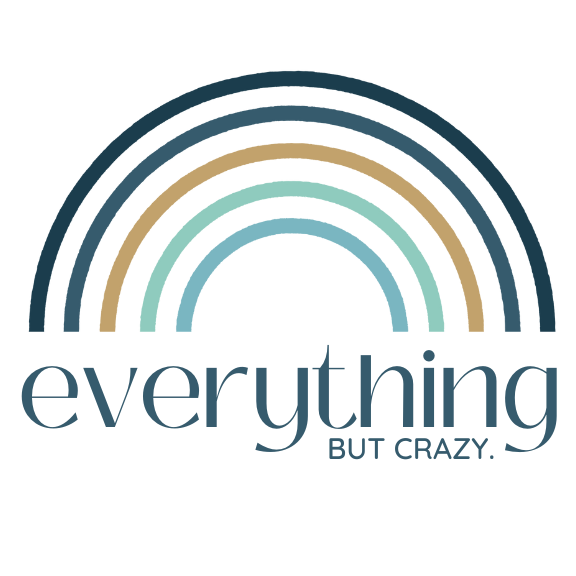Using Distraction Techniques To Cope with Intense Emotions
We all have moments when our emotions become really intense and we’re desperate for strategies to help us calm that down. Distraction techniques are a set of helpful tools that can turn down the heat and allow us to better deal with the situation contributing to our difficult feelings.
How Do Distraction Techniques Work?
As I mentioned, distraction techniques are used to help people cope with difficult and intense emotions. The way these tools are effective is by redirecting the focus of our attention to something other than those feelings. Because typically, when our emotions get that high, we become engrossed in them. At the extreme, this might correlate with tunnel vision, inability to think, panic, impulsivity, explosions, fight or flight responses, and more.
Nothing helpful typically happens at this level, and so finding ways to reduce the intensity is to your benefit.
Distraction Versus Avoidance
Finding ways to temporarily distract yourself from intense emotions is helpful, but when this becomes permanent, it actually becomes harmful. This is when distraction turns into avoidance.
The long-term avoidance of emotions interrupts our ability to take advantage of the messages those feelings are telling us. Because there’s a reason our feelings are there. They might not be convenient, or comfortable, but they are there to guide us in caring for ourselves.
So we don’t want to avoid that source of information long-term, but we also want to give ourselves a reprieve when we need it. So how do we find that balance?
Distraction Techniques
The distraction techniques listed below are ideas on how to temporarily distract yourself in order to reduce the intensity of your emotion. Some ideas might appeal to you, while others do not. The goal is not necessarily to use ALL the tools, but to have enough options that you can figure out what’s right for you.
If you try something out and it causes more stress, then it is probably not the right distraction technique for you. If you find yourself in that position, move on and try something else, until you find something that works for you.
Categories Game
The categories game is a form of mental challenge in which you choose a category (ex: names of people, vacation destinations, brands of clothing, etc) and try to list items in that category. The simple version of this activity involves listing items in random order,
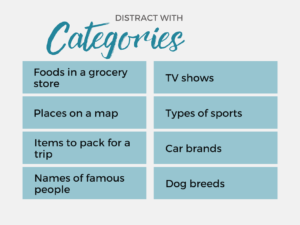 but you can make it more difficult by having to name items in alphabetical order. For example, if you were challenging yourself on the places on a map category, you might start out by naming Alaska, Bolivia, Canada, Delaware, England, Frankfurt, Galveston, etc. (As you can see, there is no firm structure here. You might list states, countries, cities, rivers, national parks, etc.).
but you can make it more difficult by having to name items in alphabetical order. For example, if you were challenging yourself on the places on a map category, you might start out by naming Alaska, Bolivia, Canada, Delaware, England, Frankfurt, Galveston, etc. (As you can see, there is no firm structure here. You might list states, countries, cities, rivers, national parks, etc.).
There is no need to maintain rigid rules in this game. For example, if you’re struggling to come up with a word for something in the grocery store that starts with U and you list “umbrella”, it’s all good! There might even be an umbrella in that grocery store. And even if there isn’t, the point of this activity is not to be 100% accurate, but to distract yourself from your intense emotion. Allow yourself some grace here.
Visualization
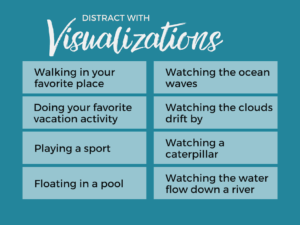 Visualization is a technique in which you imagine something in your mind. Sometimes that imagery involves you doing something (such as playing basketball, walking, or driving home from work) while other times you might imagine a scene that you are passively observing (such as clouds floating in the sky, leaves falling from a tree, or water flowing down a river).
Visualization is a technique in which you imagine something in your mind. Sometimes that imagery involves you doing something (such as playing basketball, walking, or driving home from work) while other times you might imagine a scene that you are passively observing (such as clouds floating in the sky, leaves falling from a tree, or water flowing down a river).
When using this technique, you want to make sure you choose an image of something that is either positive or neutral. The last thing you need is to conjure up an image of yourself doing something you hate, which will likely only exacerbate your stress. So take your time to identify an image that you find soothing or peaceful, and feel free to modify as much as needed.
Music
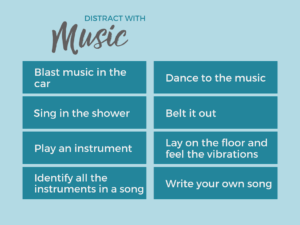 Music is such an incredibly powerful force, and there are so many ways to use music to distract yourself when you need it. You might consider singing in the shower, blasting your favorite song and singing along with it, dancing or swaying to the beat, laying still and allowing the music to fill your soul, or utilizing any talents you may already have and playing your own music on an instrument.
Music is such an incredibly powerful force, and there are so many ways to use music to distract yourself when you need it. You might consider singing in the shower, blasting your favorite song and singing along with it, dancing or swaying to the beat, laying still and allowing the music to fill your soul, or utilizing any talents you may already have and playing your own music on an instrument.
The possibilities of how to use music are endless, but there is also flexibility in the style of music you choose. There might be times when you need loud, angry heavy metal. At other times, you might crave soft, calming new age music. There is also pop, classical, folk, alternative, rock, hip hop, country, and more! Different moods might pull you to different genres. Feel free to play around and see what matches your needs.
Math
 Some people find visualization to be either difficult or unhelpful, but instead find the structure and straightforwardness of math to be a helpful tool to use when emotional intensity is high. While the idea of mental math may seem intimidating to some, you can make it as simple or complicated as you wish.
Some people find visualization to be either difficult or unhelpful, but instead find the structure and straightforwardness of math to be a helpful tool to use when emotional intensity is high. While the idea of mental math may seem intimidating to some, you can make it as simple or complicated as you wish.
For those looking for simple math to use as a distraction, consider counting forwards or backwards in increments of 2s, 5s, or 10s. You may also consider doing some simple addition (1+1=2, 1+2=3, etc) or reciting the multiplication tables.
For those looking for a harder math challenge, you might consider counting forward or backwards by 7s or 13s, adding together two random large numbers (246+354=?), or subtracting money ($23 – $8.39=?). There are lots of ways to challenge your brain here, if it feels helpful to do so.
Creativity
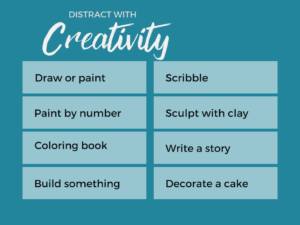 Distractions are all about shifting our hyper-focus on our feelings to something else, and engaging in something creative is an awesome way to do that. That is because creative activities have a way of allowing us to be fully engrossed in the activity and forget about everything else that was happening in our head. We can truly get into “the zone,” a blissful place where everything else just stops for a moment.
Distractions are all about shifting our hyper-focus on our feelings to something else, and engaging in something creative is an awesome way to do that. That is because creative activities have a way of allowing us to be fully engrossed in the activity and forget about everything else that was happening in our head. We can truly get into “the zone,” a blissful place where everything else just stops for a moment.
There are SO many ways to be creative, and no right or wrong way of doing it. If you’re one of those people that says things like “that won’t work for me because I can’t draw,” or “I’m not creative,” then you are writing off a whole array of techniques you might actually love.
There is no talent required to benefit from the process of creating. It isn’t about the product, it’s about the process. Instead of thinking about how successful a finished product will be, consider what would feel good to make.
Sensory Experiences
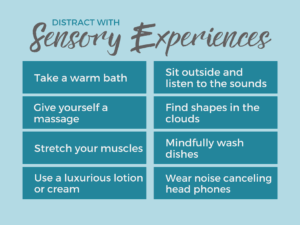 Finally, sensory experiences are one more way to take your focus from out of your head and onto something else. Sensory experiences are well-equipped for the job, because focusing on our senses is a powerful way to help ground us in the moment.
Finally, sensory experiences are one more way to take your focus from out of your head and onto something else. Sensory experiences are well-equipped for the job, because focusing on our senses is a powerful way to help ground us in the moment.
If you’re wondering what sensory experiences are, you need only think about the information that transmits to each of your senses. Think sight, sound, touch, smell, and taste.
You might choose something that soothes your senses (like taking a bath, diffusing some lavender essential oil, or massaging your muscles). You might consider something that stimulates your senses (like eating a hot pepper, or jumping into a cold pool). Or you might simply engage in an activity that allows you to be mindful of your senses (like sitting outside in nature or mindfully eating a sweet treat).
These are just some ideas you can consider when needing to temporarily distract yourself from your feelings, but there are also many more not listed here. Consider the ideas listed, but feel free to tend to your own calling. I highly recommend coming up with a few ideas ahead of time, so when you’re in the heat of the moment, you can quickly and easily turn to that activity to help you calm down. Better yet, once you have a few ideas, write them down somewhere you can access them later, whether that’s on your phone, near your bedside table, a note in your wallet, or a sticky on your bathroom mirror. Happy distracting!
_____
Dana Basu, PsyD is a licensed clinical psychologist at EverGROW therapy and founder of Everything But Crazy, an online resource for parents. She provides individual therapy, support groups, and online resources for parents in Orange County and throughout the state of California via online therapy. She specializes in working with the highly sensitive person and people with difficult childhood experiences, trauma, parenting stress, and chronic guilt.
